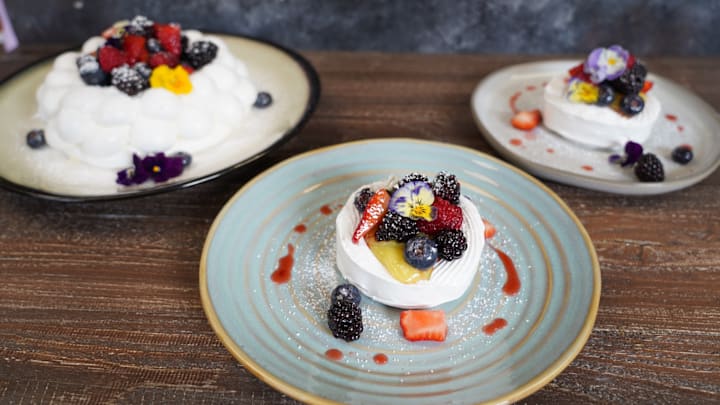Though pavlova’s country of origin is hotly debated, the dessert is enjoyed around the world today. The meringue dessert is usually topped with fruits and whipped cream, and egg whites are an essential part of the traditional recipe. But you shouldn’t miss out on the treat if you’re vegan—or trying to cut back on eggs. This version from the Institute of Culinary Education swaps the egg whites for aquafaba, or the reserved liquid from canned chickpeas, making it both nutritious and resourceful.
When you whip your pavlova together, avoid over-beating the mixture. Chef Missy Smith-Chapman, the lead chef instructor of plant-based culinary arts at ICE’s Los Angeles campus, tells Mental Floss that over-mixing leads to separation and weeping, which occurs when brown liquid appears on top of a meringue and pools at the bottom of the dessert. According to Tasting Table, other causes of weeping include adding too much sugar to the mixture and using oil or fat. Follow these easy steps to ensure your pavlova comes out perfect.
First, preheat your oven to 200˚F and place the aquafaba into the stand mixer bowl with a whisk attachment. Add the cream of tartar and mix everything on medium speed until the mixture gets foamy, which usually takes about two to three minutes. At this point, you can gradually pour in the sugar and vanilla before boosting the mixer’s speed to high. Whip the ingredients together until stiff peaks form, taking care not to over-mix.
Now it’s time to spoon the meringue onto a baking pan with parchment paper. If you’re making individual portions, discs should span about three to four inches; otherwise, one large eight-inch disc will do. Either way, you should gently spread the top layer to make room for the fruit. Place the pavlova in the oven for about two to three hours. The finished dessert should easily come off the parchment.
Once that’s done, you can place the meringue on a dish, top it with whipped cream (or lemon curd, if you’re craving a citrusy flavor) and fresh berries. The last step is to enjoy the treat.
Want to take your culinary skills to the next level? The Institute of Culinary Education offers top-notch programs in different subjects, such as pastry baking and hospitality, at its New York and Los Angeles campuses. For more information, check out ICE’s website.
Aquafaba Meringues
Yields: 6 individual or 1 large meringue
¾ cup aquafaba (from one 15-16 oz. can chickpeas, drained liquid)
¼ teaspoon cream of tartar
½ cup cane sugar
1 teaspoon vanilla extract
- Preheat oven to 200˚F.
- Place aquafaba into the bowl of a stand mixer with the whisk attachment.
- Add cream of tartar and whip on medium speed until foamy, 2–3 minutes.
- Slowly rain in the sugar, followed by vanilla or other flavoring.
- Increase speed to high and continue to whip until the mixture reaches stiff peaks. Do not over-mix.
- Spoon meringue onto a parchment-lined sheet pan and spread out. Make a 3–4-inch disc for individual portions or an 8-inch disc for a larger format.
- Bake for 2–3 hours until the meringue removes from the parchment easily.
- Place on a platter or plate, and top with whipped cream or lemon curd with fresh berries.
Read More Recipes:
